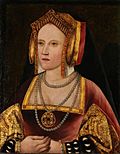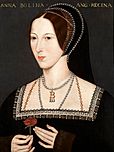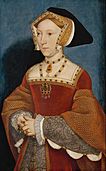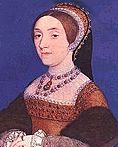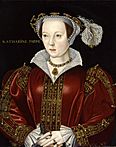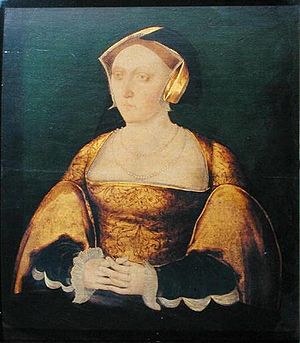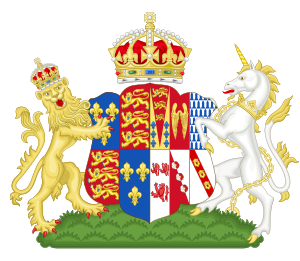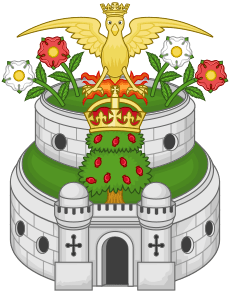Jane Seymour facts for kids
Quick facts for kids Jane Seymour |
|
|---|---|

Portrait by Hans Holbein, Kunsthistorisches Museum
|
|
| Queen consort of England | |
| Tenure | 30 May 1536 – 24 October 1537 |
| Proclamation | 4 June 1536 |
| Born | c. 1508 |
| Died | 24 October 1537 (aged c. 28–29) Hampton Court Palace, England |
| Burial | 12 November 1537 St George's Chapel, Windsor Castle, England |
| Spouse | |
| Issue | Edward VI of England |
| House | Seymour |
| Father | Sir John Seymour |
| Mother | Margery Wentworth |
| Religion | Roman Catholicism |
| Signature | |
Jane Seymour (born around 1508 – died 24 October 1537) was the Queen of England. She was the third wife of King Henry VIII of England. They married on 30 May 1536. She became queen after Henry's second wife, Anne Boleyn, was executed. Jane died less than two weeks after giving birth to her only child, who would become King Edward VI. She was the only one of Henry's wives to have a queen's funeral. She was also buried next to him in St George's Chapel, Windsor Castle.
Contents
Early Life of Jane Seymour
Jane was the daughter of Sir John Seymour and Margery Wentworth. She was most likely born at Wulfhall, Wiltshire, England. Her exact birth date is not known, but it's thought to be around 1508. Through her mother's family, Jane was related to King Edward III. This made her and King Henry VIII distant cousins.
Jane did not have as much formal education as Henry's first two wives. She could read and write a little. However, she was very skilled at needlework and managing a household. These were important skills for women at that time. Her needlework was known to be very beautiful.
Jane started working for the royal family in 1532. She was a maid-of-honour to Queen Catherine. Later, she served Queen Anne, along with her sister Elizabeth. King Henry VIII first showed interest in Jane in February 1536. This was about three months before Anne Boleyn's execution.
People often praised Jane for her kind and peaceful nature. She was called "gentle" and "the Pacific" because she tried to make peace at court. Some described her as not very beautiful, but others said she was "the fairest of all the King's wives." She was seen as humble, gentle, and pure. Her large family made people believe she would be able to have many children.
Marriage to King Henry VIII
(1509–1533)
(1533–1536)
(1536–1537)
(1540)
(1540–1542)
(1543–1547)
Henry VIII became engaged to Jane on 20 May 1536. This was the day after Anne Boleyn was executed. They married at the Palace of Whitehall in London on 30 May 1536. As a wedding gift, Henry gave her many lands and hunting areas. These would provide her with income as queen. She was officially announced as queen on 4 June 1536.
Jane was popular with the public and many at court. This was because she showed kindness to the late Queen Catherine and her daughter Mary. Jane was never officially crowned queen. This was partly because of the plague in London. Also, Henry might have wanted her to have a male heir first.
As queen, Jane was known for being strict and formal. The fun and lavish parties of Anne Boleyn's time were replaced with very proper rules. Jane even banned the French fashions that Anne had brought to court. Jane's motto as queen was Bound to obey and serve.
Jane became close with Henry's daughter, Mary. Jane worked hard to help Mary return to court. She also wanted Mary to be part of the royal succession again. Jane talked about Mary's return both before and after she became queen. While she couldn't get Mary back in line for the throne, she did help Mary and Henry make up.
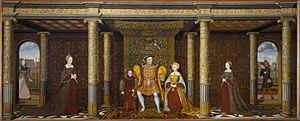
Birth of an Heir
In January 1537, Jane became pregnant again. During her pregnancy, she wanted to eat quail. Henry ordered this special food for her from other countries. That summer, she stayed out of public view. She lived a quiet life, cared for by royal doctors and the best midwives.
Jane gave birth to a son, the future King Edward VI. He was born at 2:00 AM on 12 October 1537 at Hampton Court Palace. Edward was christened on 15 October 1537. His mother, Jane, did not attend, as was the custom. Edward was the only legitimate son of Henry VIII to survive childhood. Both of his half-sisters, Mary and Elizabeth, were at the christening.
Queen Jane's Death and Funeral
Jane's labour was very difficult. It lasted two days and three nights. After the christening, it became clear that she was very ill. She died on 24 October 1537 at Hampton Court Palace. Her death was likely caused by an infection or complications after childbirth.
Jane was buried on 12 November 1537. Her funeral was held at St. George's Chapel at Windsor Castle. Her stepdaughter Mary was the main mourner. Jane was the only one of Henry's wives to receive a queen's funeral.
After Jane's death, Henry wore black clothes for three months. He married Anne of Cleves two years later. Henry gained weight during this time. Historians believe Jane was his favourite wife because she gave him a son. When Henry died in 1547, he was buried next to Jane, as he had wished.
Jane Seymour's Legacy
Jane gave King Henry the son he desperately wanted. She also helped Mary return to court and to her father's good graces. Jane used her influence to help her own family. Two of her brothers, Thomas and Edward, used her memory to improve their own positions.
Thomas was rumored to be interested in the future Elizabeth I. However, he married the queen dowager Catherine Parr instead. When the young King Edward VI was on the throne, Edward Seymour became the Lord Protector. This meant he was the real ruler of the kingdom. Both brothers eventually lost their power and were executed.
See also
 In Spanish: Juana Seymour para niños
In Spanish: Juana Seymour para niños


